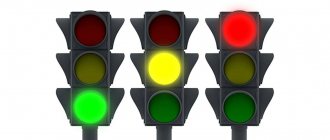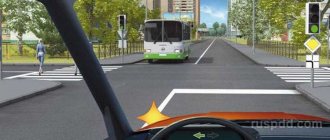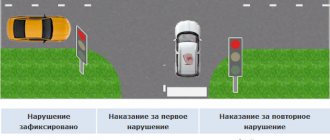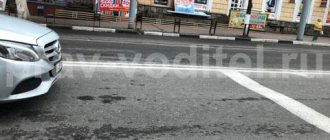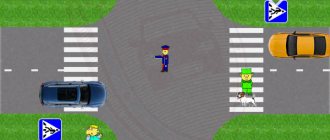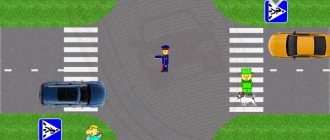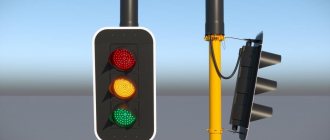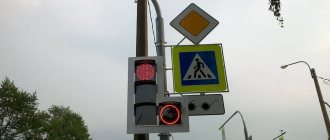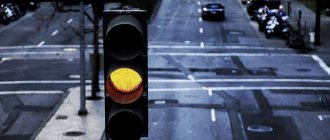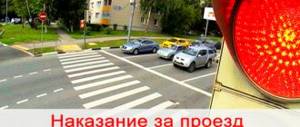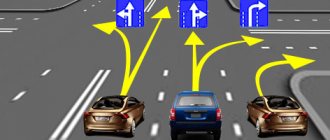What does a flashing green traffic light mean?
| 1. | Warns of a traffic light malfunction. |
| 2. | Allows movement and informs that a prohibitory signal will soon be turned on. |
| 3. | Prohibits further movement. |
To inform drivers about the upcoming change of the green traffic light to yellow, the Rules provide for the possibility of flashing the green signal. This signal allows the vehicle to move. The blinking duration should be 3 seconds.
Basic traffic light signals
A traditional traffic light produces three light signals: green, yellow and red. The device is installed at intersections and near pedestrian crossings. Following traffic signs helps prevent accidents by ensuring the safety of both pedestrians and motorists. Each color has one or more meanings enshrined in traffic rules. Let's look at them in more detail:
- Green – allows movement for both vehicles and pedestrians.
- If the green light is flashing, then the vehicles can continue driving, but drivers should take into account that the prohibiting signal will soon be turned on, and therefore the maneuver should be completed as soon as possible. Digital displays can be used to provide more accurate information about the remaining time.
- Yellow light – warns of a change in traffic lights. It prohibits movement except for those cases provided for in paragraph 6.14 of the traffic rules.
- Flashing yellow. Allows traffic and warns about the presence of an unregulated intersection (if the traffic light is not working), informing about the danger. Upon seeing a flashing yellow light, the driver should cross the intersection with maximum vigilance.
- Red. Used to prohibit movement. It doesn’t matter whether the light is red or blinking.
- The combination of yellow and red colors has two functions. The first is prohibitive (you can’t move). The second is a warning (the light will turn green soon, so drivers should get ready to start).
You intend to turn left. Your actions?
| 1. | Give way to the tram. |
| 2. | Go through the intersection first. |
| 3. | Wait for the permission signal from a special traffic light and only then turn. |
A green traffic light allows you to turn left. The movement of the tram at this intersection is regulated by a single-color traffic light in the form of the letter “T”. Considering that with such a signal the tram is prohibited from moving, you can pass the intersection first.
Traffic regulations | 6. Traffic lights and traffic controller signals
Home / Traffic rules of the Russian Federation / Section 6.
Traffic regulations SignsMarking Vehicle approval
Traffic rules:
6.1. Traffic lights use green, yellow, red and white-lunar light signals.
Depending on the purpose, traffic light signals can be round, in the form of an arrow(s), a silhouette of a pedestrian or a bicycle, or X-shaped.
Traffic lights with round signals may have one or two additional sections with signals in the form of a green arrow(s), which are located at the level of the green round signal.
6.2. Round traffic lights have the following meanings:
- A green signal allows movement;
- A green flashing signal allows movement and informs that its time is expiring and a prohibitory signal will soon be turned on (digital displays can be used to inform drivers about the time in seconds remaining until the end of the green signal);
- The yellow signal prohibits movement, except in cases provided for in paragraph 6.14 of the Rules, and warns of an upcoming change of signals;
- A yellow flashing signal allows movement and informs about the presence of an unregulated intersection or pedestrian crossing, warns of danger;
- A red signal , including a flashing one, prohibits movement.
The combination of red and yellow signals prohibits movement and informs about the upcoming activation of the green signal.
6.3. Traffic light signals, made in the form of red, yellow and green arrows, have the same meaning as round signals of the corresponding color, but their effect extends only to the direction(s) indicated by the arrows. In this case, the arrow allowing a left turn also allows a U-turn, unless this is prohibited by the corresponding road sign.
The green arrow in the additional section has the same meaning. A switched off signal of an additional section or a switched on red light signal of its outline means that movement in the direction regulated by this section is prohibited.
Directions of movement at different traffic lights with one additional section (arrow)
Driving directions for different traffic lights with two additional sections (arrows)
6.4. If a black contour arrow(s) is applied to the main green traffic light signal, it informs drivers about the presence of an additional section of the traffic light and indicates other permitted directions of movement than the additional section signal.
6.5. If a traffic light signal is made in the form of a silhouette of a pedestrian and (or) a bicycle, then its effect applies only to pedestrians (cyclists). In this case, the green signal allows, and the red signal prohibits, the movement of pedestrians (cyclists).
To regulate the movement of cyclists, a traffic light with round signals of reduced size, complemented by a rectangular white plate measuring 200x200 mm with a picture of a black bicycle, can also be used.
6.6. To inform blind pedestrians about the possibility of crossing the roadway, traffic light signals can be supplemented with an audible signal.
6.7. To regulate the movement of vehicles along lanes of the roadway, in particular along those in which the direction of movement can change to the opposite, reversible traffic lights with a red X-shaped signal and a green signal in the form of an arrow pointing downwards are used. These signals respectively prohibit or allow movement in the lane above which they are located.
The main signals of a reversible traffic light can be supplemented by a yellow signal in the form of an arrow, tilted diagonally down to the right or left, the inclusion of which informs about the upcoming change of signal and the need to change lanes to which the arrow points.
When the signals of the reversing traffic light, which is located above the lane marked on both sides by markings 1.9, are turned off, entry into this lane is prohibited.
6.8. To regulate the movement of trams, as well as other route vehicles moving along the lane allocated for them, single-color traffic lights with four round white-moon colored signals located in the shape of the letter “T” can be used. Movement is permitted only when the lower signal and one or more upper ones are turned on simultaneously, of which the left one allows movement to the left, the middle one allows movement straight, and the right one allows movement to the right. If only the top three signals are on, then movement is prohibited.
Directions of movement of trams at different traffic lights of a single-color white-lunar signal
6.9. A round white-lunar flashing signal located at a railroad crossing allows vehicles to move through the crossing. When the flashing white-lunar and red signals are turned off, movement is permitted if there is no train (locomotive, handcar) approaching the crossing within sight.
6.10. The traffic controller signals have the following meanings:
- Arms extended to the sides or lowered:
- from the left and right sides, the tram is allowed to move straight, trackless vehicles straight and to the right, pedestrians are allowed to cross the roadway;
- from the chest and back, the movement of all vehicles and pedestrians is prohibited.
- Right arm extended forward:
- from the left side, trams are allowed to move to the left, and trackless vehicles in all directions;
- from the chest side, all vehicles are allowed to move only to the right;
- from the right side and back, the movement of all vehicles is prohibited;
- Pedestrians are allowed to cross the road behind the traffic controller.
- the movement of all vehicles and pedestrians is prohibited in all directions, except as provided for in paragraph 6.14 of the Rules.
The traffic controller can give hand gestures and other signals that are understandable to drivers and pedestrians.
For better visibility of signals, the traffic controller can use a rod or disk with a red signal (retroreflector).
Directions of movement at different traffic controller signals
6.11. A request to stop a vehicle is made using a loud-speaking device or a hand gesture directed at the vehicle. The driver must stop at the place indicated to him.
6.12. An additional whistle signal is given to attract the attention of traffic participants.
6.13. When there is a prohibitory signal from a traffic light (except a reversing one) or from a traffic controller, drivers must stop in front of the stop line (sign 6.16), and in its absence:
- at an intersection - in front of the roadway being crossed (taking into account clause 13.7 of the Rules), without interfering with pedestrians;
- before a railway crossing - in accordance with clause 15.4 of the Rules;
- in other places - in front of a traffic light or traffic controller, without interfering with vehicles and pedestrians whose movement is permitted.
6.14. Drivers who, when the yellow signal turns on or the traffic controller raises his hand up, cannot stop without resorting to emergency braking in the places determined by paragraph 6.13 of the Rules, are allowed to continue driving.
Pedestrians who were on the roadway when the signal was given must clear it, and if this is not possible, stop on the line dividing traffic flows in opposite directions.
6.15. Drivers and pedestrians must comply with the signals and orders of the traffic controller, even if they contradict traffic light signals, road signs or markings.
If the meanings of traffic light signals contradict the requirements of priority road signs, drivers must be guided by the traffic light signals.
6.16. At railway crossings, simultaneously with the red flashing traffic light, an audible signal may be sounded, additionally informing traffic participants that movement through the crossing is prohibited.
Comments (37)
| Salavat 07/03/2019 at 16:30 At night, when the green light is on, you cannot see the arrow at all with the additional section to the left. Take the 107 Moscow ring road. And the patrol service is all grazing there at night! Take even statistics on fines, how many fines are issued per day in the Moscow region. [Reply] [Cancel reply] | +1 |
| Diman 07/13/2019 at 08:42 clause 6.4 of the rules. if there is an additional section (arrow), then the main round green traffic light signal has a black contour arrow... [Reply] [Cancel reply] | -2 |
| Yeah 11/15/2019 at 04:07 Yeah, only there are a lot of traffic lights with an additional section, but the main one without arrows [Reply] [Cancel reply] | -4 |
| Vladislav 03/24/2020 at 15:24 Then you can go in all directions. They even talked about it on TV. [Reply] [Cancel reply] | 0 |
| Vladimir 07/02/2019 at 06:18 Please tell me, a double intersection, three lanes in one direction. turn left and turn from the right lane (highlighted solid until the second traffic light with an arrow to the left), a bump stop on the right. on the first, in the direction of travel there is green in the main section and a red ring in the additional one on the right, under the ring there is a green arrow straight (visible only when it is on). in this case, is driving straight ahead in the right lane until the next traffic light to turn under the left arrow allowed? [Reply] [Cancel reply] | -1 |
| !!! 05/19/2019 at 18:34 Isn’t it possible to go to the right from any lane at a red light if the green arrow is on below or on the sign near the red one?? At the same time, road signs show that you can drive to the right from any lane??? so the signs only show driving when the light is green?? [Reply] [Cancel reply] | 0 |
| Alexander 95 03/11/2019 at 07:45 Help me figure it out. The intersection is "t" shaped. Move straight and to the right. There is a light light with an additional section. The main light is green (I especially note that there is no outline arrow on it). The additional one to the right does not light up. Is it possible to turn right? [Reply] [Cancel reply] | +1 |
| Yuri 05/17/2019 at 20:03 You can drive, if the arrow is green, you can drive in all directions. [Reply] [Cancel reply] | +7 |
| Alexey 04/20/2019 at 11:42 No, of course not, because there is an additional section. If it were possible to turn, then why the hell is this additional section hanging there? So wait for the extra right with the green arrow [Reply] [Cancel reply] | -2 |
| Alexander 01/30/2020 at 08:54 Learn the rules [Reply] [Cancel reply] | +1 |
| Alexander 01/05/2020 at 06:08 Read carefully the meaning of traffic lights. You can go, because on the MAIN section of the traffic light there is no silhouette in the form of a black arrow, which informs about the presence of additional traffic lights. sections allowing/prohibiting movement in the appropriate direction. Accordingly, it is possible. [Reply] [Cancel reply] | 0 |
| Valery 11/10/2019 at 6:32 pm hand over your license back to the traffic police and sign up for a driving school. If the main traffic light does not have arrows indicating the direction of movement, it allows traffic in all directions despite the presence of an additional section. and the section will allow movement when the main red light is on, provided that there is no interference with those driving on their green [Reply] [Cancel reply] | +4 |
| Alexey 03/11/2020 at 14:21 Which paragraph is this indicated? [Reply] [Cancel reply] | 0 |
| Gai 11/12/2019 at 02:42 pm Learn the rules [Reply] [Cancel reply] | 0 |
| Anonymous 11/20/2019 at 8:42 pm Alexey is right. For movement in all directions, the main green light is turned on simultaneously with the additional green light. section [Reply] [Cancel reply] | 0 |
| Andrey 08/26/2018 at 10:25 Main road sign, the main red one is on and the additional green section on the right is on. On the perpendicular road the main green light is on, but the give way sign! Who has priority? [Reply] [Cancel reply] | 0 |
| Nikolay 09.22.2018 at 20:12 When the traffic light is working, the priority signs do not work! [Reply] [Cancel reply] | +10 |
| Andrey 09.27.2018 at 15:35 Well, who is inferior to whom? [Reply] [Cancel reply] | +3 |
| Alexandra 10/03/2018 at 03:58 Drivers with a red light and a green arrow are giving way. Because the combination of these signals allows traffic only to the right, but informs that you need to give way. At a working traffic light, priority signs are not valid. [Reply] [Cancel reply] | +9 |
| Vladimir 08/06/2018 at 19:00 The main green and green additional section “to the left” are lit for me. 1) Do I have an advantage over oncoming oncoming traffic when turning left? and 2) How to find out - Which traffic light is on for them (oncoming traffic) in this situation - Main RED or GREEN? Logically, can the oncoming traffic light turn green at this moment? Or is logic powerless here? [Reply] [Cancel reply] | +3 |
| Alexander 10/12/2018 at 01:54 If the oncoming traffic has stopped, then it is red. And if the outer row turns at this time, then the main section is red, and the additional section is green. Not only intuition, experience and caution. There is no advantage if oncoming traffic is approaching the main signal, you have interference on the right when turning left. [Reply] [Cancel reply] | +6 |
| Alexandra 10/03/2018 at 04:02 When yours is green, theirs is 100% red. [Reply] [Cancel reply] | +3 |
| Yuri 06/07/2019 at 18:07 And you will take a ride to Tver. You will be very surprised. [Reply] [Cancel reply] | 0 |
| Alexander 10/12/2018 at 01:45 Why is the red light on at the intersection? [Reply] [Cancel reply] | +4 |
| Victor 06/05/2018 at 09:58 Is it possible to turn it? If the additional green arrow is off, and there are no arrows drawn on the main green one (direction of movements). [Reply] [Cancel reply] | +5 |
| Alexander 10/12/2018 at 01:59 If there are no arrows on the main green, then the turned on signal allows movement in all directions. CAN BE ROTATED. [Reply] [Cancel reply] | +4 |
| Alexander 06/05/2018 at 16:24 IMPOSSIBLE. An outline arrow placed on a green traffic light signal indicates that the traffic light has an additional section to make it easier for drivers to navigate (If a black outline arrow(s) is applied to the main green traffic light signal, then it informs drivers about the presence of an additional section of the traffic light and indicates other permitted directions of movement than the signal of the additional section), but (the signal of the additional section is turned off or the red light signal of its outline is turned on means that movement in the direction regulated by this section is prohibited.) Traffic lights with additional. sections can be without a contour arrow. [Reply] [Cancel reply] | +6 |
| Dmitry 04/30/2019 at 16:24 So the person had a question (I translate): if there are NOT any arrows on the green field of the main section, and the additional section is turned off and you are not VANGA and don’t know what’s there on this section - how is the intersection navigated? [Reply] [Cancel reply] | +3 |
| Elena 04/03/2018 at 20:28 Thank you. Helps a lot when studying [Reply] [Cancel reply] | +3 |
| Elena 04/03/2018 at 20:26 I’m studying too. Helps. [Reply] [Cancel reply] | +3 |
| Alexander 03/14/2018 at 12:25 First, on a special highway, namely RUBLEVKA! Teach the guys how to regulate and then ask the driver. I clashed with the major. So according to HIS RULES, since he stopped it, it means I’m already guilty. What? I'll find it for you. Class. They also teach us. [Reply] [Cancel reply] | +3 |
| Sergey 02.22.2018 at 19:35 Passing the intersection. If there is a traffic light at the intersection, the order of passage is stipulated by the rules, but if there is a traffic controller at the intersection, the order of passage is not specified. What does it mean? When the main traffic light is red with the additional arrow to the right turned on, the driver does not have the right of way, but with the appropriate gesture from the traffic controller, the driver has the right of way. Why? [Reply] [Cancel reply] | +1 |
| Ivan 10/02/2018 at 08:57 How can you compare a traffic controller and a traffic light? The question is not correct! [Reply] [Cancel reply] | +3 |
| Alexander 03/14/2018 at 12:37 But because it is written by an oak and signed by a moron. It seems to be perceived that way. And look... There is no English. Smart people wrote .. What are they .. You, dear ogre... should be fined. And when you come to our beloved data center... In short... I’m the boss, you’re a fool... In short, you understand... And you will act as Mi and deprive a pedestrian of your rights... You will crawl on your belly!!! Get out of here, stinking slave!!! [Reply] [Cancel reply] | +4 |
| Anastasia Natashevich 02/02/2018 at 06:58 Finally, I found pictures with “answers” (hints on where to go). Hooray! [Reply] [Cancel reply] | +7 |
| Anna 08.28.2017 at 17:42 thank you all) [Reply] [Cancel reply] | +6 |
| ALEXEY 08/09/2017 at 12:37 GOOD SITE I RECOMMEND [Reply] [Cancel reply] | -2 |
coming
News
03/26/2021 Changes in the practical part of the traffic rules exam from April 1, 2021
03/01/2021 New sign 6.22 “Photo and video recording” in traffic rules
All news
In what case are you obliged to give way to a tram?
| 1. | When driving straight. |
| 2. | In both of the above cases. |
| 3. | When turning left. |
The turned on turn signal informs you that the paths of your car and the tram intersect at an intersection. Considering that this traffic light simultaneously allows you and the tram driver to move, you are obliged to give way to the tram.
Everyone learns traffic rules from kindergarten. However, when getting behind the wheel, many begin to get confused about basic things, including the designation of traffic light colors. Seeing a yellow light, drivers press on the gas even harder, trying to get through the intersection as quickly as possible. Their neighbors from the perpendicular road also react accordingly and hit the gas, not wanting to wait for the green light. As a result, both of them find themselves in a stupid situation. So is it possible to drive through an intersection on yellow?
The rules give a clear answer. According to clause 6.2 of the traffic rules, a yellow signal strictly prohibits movement and you cannot start when the traffic light is yellow.
However, there are two exceptions. According to paragraph 6.14 of the traffic rules, if the car does not have time to slow down smoothly and emergency braking poses a danger, then you can continue driving.
This is taken advantage of by many drivers in a hurry, who pretend not to notice the flashing green, and then flashing yellow, and rush past the traffic light. Often such passages end in accidents, since the same rusher can jump out towards you, and then it depends only on the driver’s reaction whether a tragedy will happen or everything will be ok with body repairs. Traffic accident inspectors arriving at the scene try to understand the situation and find the culprit.
Another point of the traffic rules helps to do this - 13.8. He says that when the traffic light turns on, the driver is still required to give way to cars and pedestrians who are at the intersection.
Therefore, often a driver who does not allow someone rushing to turn yellow may be found guilty. However, more often than not, inspectors rule on mutual guilt. And such a verdict results in problems with the registration of compulsory motor liability insurance.
In general, driving through a yellow traffic light is a game of Russian roulette, the prize for which is a couple of minutes of extra time, and the punishment for losing is a damaged car. Therefore, it is best to hold your horses and start slowing down in advance, not even for yellow, but for flashing green.
However, there is one more exception that allows you to drive on a yellow traffic light. This is a flashing yellow section that warns drivers when they are approaching a dangerous intersection. Usually this traffic light mode is turned on at night. In this case, the order of passage through the intersection is determined by road signs hanging next to the traffic light.
Author: Vladimir Gavrilov
You intend to turn left. Your actions?
| 1. | Turn left, stop at the break in the dividing strip and, after turning on the permitting traffic light at the exit from the intersection, complete the maneuver. |
| 2. | Perform a maneuver without stopping at an intersection. |
A green traffic light gives you the right to move left. In this case, you must drive in the intended direction regardless of the traffic light signal at the exit from the intersection.
Driving through intersections in accordance with traffic regulations
Your actions should be determined by where exactly the traffic light caught you . For example, if you are just before an intersection and the intersection is not very wide, you can continue driving when the green light is flashing.
If the red light comes on while you are still passing the intersection, you can complete the maneuver in accordance with clause 13.7 of the traffic rules. That is, when entering an intersection while the permit signal has not stopped lighting, you are obliged to continue driving to the exit.
You should not do this in only one case - if you see a traffic jam behind the intersection. According to clause 13.2. According to traffic regulations, it is prohibited to enter an intersection if there is a traffic jam at it, regardless of the traffic light signal.
If it is still a long way to the edge of the roadway, the traffic light begins to flash, and you are moving slowly, you should not speed up - stop in front of the intersection and wait for the required signal. After the green signal, the yellow one will turn on - according to clause 6.2 of the traffic rules, it prohibits further driving (read about what the consequences may be when driving through a yellow traffic light here.
For vehicles that can no longer stop because they have already entered the roadway, provisions are provided in clause 6.14 of the traffic rules. In this case, sanctions for violation depend on how the traffic police inspector treats the situation.
When a car drives onto the road, the driver must remember the responsibility and punishment for violating traffic rules. We advise you to look at our articles about what happens for running a red light through a railway crossing, as well as crossing a stop line in front of a traffic light.
You intend to turn left. Your actions?
| 1. | Having arrived at the intersection, stop at the stop line and, after waiting for the green traffic light on the dividing strip, complete the maneuver. |
| 2. | Perform a maneuver without stopping at an intersection. |
A green traffic light gives you the right to move left. But, since at this intersection there is a stop line in front of the traffic light installed on the dividing strip, you must stop in front of it and wait for the green signal.
Curious facts
- The first traffic light, consisting of three color signals, was installed in Detroit back in 1920.
- The year 1930 was significant with the appearance of the first traffic light in Russia. It was installed between Liteiny and Nevsky prospects. Soon after this, in the same year, a traffic light could be seen in the capital.
- The most complex traffic light is rightfully considered to be the one located in Berlin. It has thirteen signals!
- According to experts, people living in megacities spend up to six months of their lives just waiting for a green traffic light.
- To avoid attacks and robberies in disadvantaged areas of Rio de Janeiro, the city allows driving on red lights between ten in the evening and five in the morning.
- The color blue is difficult for drivers to perceive on the roads. The Japanese were able to verify this when they used blue instead of green at traffic lights. Soon the color signal was changed.
- In Novosibirsk and London there are traffic light monuments, which is one of the attractions of these cities.
- Surely many are wondering why red, yellow and green traffic light colors are used to regulate traffic on the roadway. Scientists explain this by the fact that these colors have the longest wavelengths in the spectrum. Therefore, the listed color signals can be seen from a long distance, which is simply necessary for road safety.
- In the very first traffic lights, the green light did not mean “Go”, but “Attention”. While white allowed us to continue moving. But due to the fact that in the dark, drivers confused this light with the shine of stars or the moon in the sky, it was decided to change the color scheme on the device.
We cannot imagine our life without traffic lights on the roads. They are the ones who guide us, drivers and pedestrians, thereby ensuring comfortable and safe road traffic in cities and countries.
You intend to drive straight through the intersection. Your actions?
| 1. | Give way to the tram. |
| 2. | Go through the intersection first. |
The turned on tram turn signal informs you that the paths of your car and the tram intersect at an intersection. Considering that the green traffic light allows you to go straight, and the tram traffic light in the shape of the letter “T” prohibits the tram from turning right, you can pass the intersection first.
You intend to drive straight through the intersection. Your actions?
| 1. | Go through the intersection first. |
| 2. | Give way only to the tram. |
| 3. | Give way to trams and cars. |
A green traffic light gives you and oncoming vehicles the right to move. In this case, you must give way only to the tram. An oncoming passenger car is not allowed to pass through the intersection together with a tram.
When turning left you:
| 1. | Must give way only to passenger cars. |
| 2. | You have the right to pass the intersection first. |
| 3. | Must give way to both vehicles. |
A green traffic light gives the right to move to all vehicles. But when turning left, you must give way to a tram, which has priority over trackless vehicles, as well as to an oncoming passenger car (traffic rules 13.4).
You intend to turn left. Who should give way to?
| 1. | Only a car. |
| 2. | Only by tram. |
| 3. | Car and tram. |
| 4. | No one. |
A green traffic light gives you and oncoming vehicles the right to move. At the same time, when turning left, you must give way to a tram and a car turning right.
In what case will you not have to give way to other road users?
| 1. | Only if you intend to continue moving straight. |
| 2. | Only if you intend to continue moving straight or to the right. |
| 3. | Anyway. |
A green traffic light allows you and the tram to move. At the same time, if you intend to move left or in the opposite direction at this intersection, you will have to give way to the tram, and when turning right - to pedestrians. Thus, only when driving straight is it not necessary to give way to anyone.
When can you drive through a red traffic light?
So, traffic police rules in most cases do not allow the driver to drive through a prohibiting traffic light. The fine for such a violation recorded by a traffic police officer or an automatic camera is 1,000 rubles, as stated in Article 12.12 of the Code of Administrative Offenses of the Russian Federation.
For a repeated violation, if it was recorded by a traffic police inspector, the motorist faces a fine of 5,000 rubles or deprivation of rights for a period of 4-6 months. If this violation was recorded by a camera, the driver will have to pay a fine of 5,000 rubles.
If a motorist runs a prohibiting traffic light at a railway crossing, the punishment will be a fine of 1,000 rubles or deprivation of a driver’s license for a period of 3 to 6 months.
Now let's look at a few exceptions. Thus, paragraph 6.15 of the Traffic Rules states that “drivers and pedestrians must comply with the requirements of signals and orders of the traffic controller.” Moreover, they are obliged to obey the instructions of the traffic controller “even if they contradict the traffic lights, the requirements of road signs or markings.” Thus, the motorist must follow the instructions of the traffic controller even if he has to drive through a prohibitory traffic light.
According to the Rules of the Road, a car with a blue flashing light on when performing an official task has priority on the road. Other road users must give way to special vehicles, and ignoring this rule will cost them from 3,000 to 5,000 rubles in fines.
It is interesting that, although the rules require the driver to always give way to special vehicles, they do not directly tell him to violate traffic rules and drive through a red traffic light. So, if a motorist obeys the rule and, giving priority to, for example, an ambulance, runs a red light, then it is possible that he will receive a fine from a video recording camera. In a good scenario, the driver may be able to prove that he could not avoid running the red light.
If there is another case when at a traffic light you can go to the prohibiting traffic light signal. It is described in paragraph 13.7 of the Traffic Rules. There, in particular, it says that if a motorist entered an intersection when the traffic light signal allowed, then he is obliged to drive in the intended direction, regardless of the traffic light signal at the exit from the intersection.
It turns out that even if the driver starts turning left and gets stuck in a traffic jam, he is obliged to continue turning and moving in the chosen direction even when the red light comes on. Other motorists are required to let such a car pass. This is stated in 13.8 of the Traffic Rules: “when the traffic light turns on, the driver is obliged to give way to vehicles completing their movement through the intersection, and to pedestrians who have not completed crossing the roadway in this direction.”
There is also a nuance when turning “under the arrow”. Thus, traffic regulations do not prohibit turning on a red traffic light if this maneuver is permitted by a lit arrow in the additional section. In this case, the driver can turn to red, but first he must give way to all cars, both oncoming and passing traffic.
Another nuance with driving at prohibitory traffic lights is described in paragraphs 6.13 and 6.14 of the Traffic Rules. Thus, there are cases when a driver who is forced to stop at a yellow traffic light (which is also a signal prohibiting movement) has to resort to emergency braking. But if the motorist cannot stop without resorting to emergency braking in places such as, for example, an intersection, a railway crossing or in front of a traffic light, then he is allowed to continue driving.
When deciding to drive through a prohibitory traffic light, even if the Traffic Rules permit it, the motorist, of course, must make sure that his maneuver is carried out in safe conditions. It is also important to understand that in doing so he does not endanger his life and the lives of other road users.
You intend to turn right. Your actions?
| 1. | Go through the intersection first. |
| 2. | Give way to both trams. |
| 3. | Give way only to tram A. |
| 4. | Give way only to tram B. |
This traffic light signal gives you and the tram drivers the right to move. And since to turn right you need to cross the tram tracks, you must give way to both trams.
